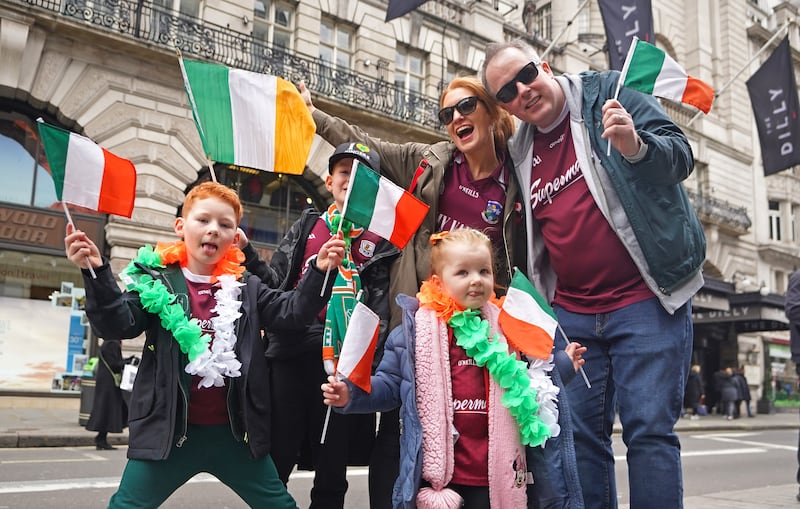The Irish took over Trafalgar Square in London on Sunday afternoon, as the city got in a few days ahead by hosting its annual St Patrick’s Day parade through the West End. Even some of the tourist stalls at the end of the Strand thoroughfare switched from selling their usual Union Jacks to the Irish tricolour.
London’s mayor, Sadiq Khan, hailed a “historic bond” between British and Irish people, which he insisted wasn’t damaged in recent years even as political skirmishes over Brexit had “soured relations” between the two nations’ governments.
“It is important not to let people divide us,” said Mr Khan, speaking to The Irish Times before he went on stage to address a crowd in London’s most famous square, where organisers had predicted up to 50,000 people would gather after the parade wound its way down from Hyde Park Corner.
The London mayor said he believed his city’s parade would be the biggest in Europe, outside of Ireland. He also acknowledged the contribution made in London by generations of Irish workers.
RM Block
“In London we have just had the 160th anniversary of the world’s first underground system. That was made possible by the work of Irish navvies,” he said.
“This year we celebrate 25 years of the Good Friday Agreement. We had great relations between Irish people and British people. Then you had [former UK prime minister] Boris Johnson and some of the stuff that went on soured relations between the governments. But it didn’t sour relations between the people.”
Mr Khan said that “whatever you think about [prime minister] Rishi Sunak”, the recent Windsor Framework deal he struck with the European Union to iron out Brexit-related trade issues in the North “bodes well” for a resumption of strong political ties.
The Irish Government was represented at the parade by Heather Humphreys, the Minister for Social Protection and also Rural and Community Development. She played down a suggestion that relations between the British and Irish governments had been damaged in recent years.
“There is a very close relationship now. The Taoiseach [Leo Varadkar] and prime minister here seem to get on very well, actually, and they’re both of Indian descent. There are a lot of good connections being made. We always have to look to the future,” she said.

Ms Humphreys, a Presbyterian who lives in Monaghan close to the Border with the North, also talked up the Windsor Framework as a harbinger of even better relations between Ireland and Britain. She said the Government was focused on giving the Democratic Unionist Party the “time and space” it needs to assess the agreement, which it is hoped could convince the DUP to end its boycott of devolved government in the North.
It’s been difficult for the last few years but we’re in a better place [now]
— Martin Fraser, the Republic’s ambassador to Britain
“I would like to think they can see there are advantages here. There are always going to be issues that need to be talked about. But it’s a good deal. But the DUP have to understand it and be happy with it. I hope they will be in a position to accept it.”
The Republic’s ambassador to Britain, Martin Fraser, said he expected the Taoiseach and President Michael D Higgins to attend the coronation in May of King Charles.
“That’s a sign of how close the two countries are. It’s been difficult for the last few years but we’re in a better place [now],” said Mr Fraser, who was appointed ambassador last November following an 11-year stint as Ireland’s most senior civil servant.
He suggested that now is perhaps a time for people in the Republic to listen to the concerns of unionists in the North, who had been angered by EU trade arrangements designed to prevent a hard border in Ireland, but which have muddled aspects of the North’s trade with Britain.
“We can’t impose our views on them. We can’t impose our desired feelings on them. We need to listen very carefully. If we can help, we should help, and we should respect their position and their right to think about their own situation.”
The parade kicked off shortly after noon, as Mr Khan, Mr Fraser and Ms Humphreys gathered at the head of the parade alongside its grand marshall, Cork expatriate Catherina Casey.
As well as the usual mix of London Irish sporting, community and county-focused groups, a splash of colour beyond green came in the form of troupes of dancers from Latin American countries such as Bolivia and Peru, whose diaspora have become a fixture at Irish celebrations in London.
“We welcome all sorts at this parade. There’s even a few Hare Krishnas down the back,” said one of the members of London Galway Association.
Members of An Garda Síochána attended to march alongside officers from the London Metropolitan Police, while another marching group was drawn from the London Fire Brigade.

The Irish tricolour was carried at the head of the parade by Letterkenny man Troy Gallagher, a Labour councillor in north London who until last year served as mayor of Islington.
A week-long series of events by London’s Irish community lies ahead. Ms Humphreys on Monday is expected to attend a gathering in Westminster organised by the Labour Party’s Irish society, led by Liam Conlon.
Baroness Frances O’Grady, a daughter of Irish immigrants who was recently appointed to the House of Lords as a Labour peer, will also attend.
Mr Conlon said the Belfast Agreement was “put under strain” by Brexit and the actions in recent years of the British government. “We will recommit ourselves to work together to build constructive, co-operative relationships across Britain and Ireland,” he said.
On Tuesday, Ms Humphreys will attend a lunch in the Irish embassy to commemorate an international rugby game held at the height of the Troubles in 1973 between England and Ireland.


















